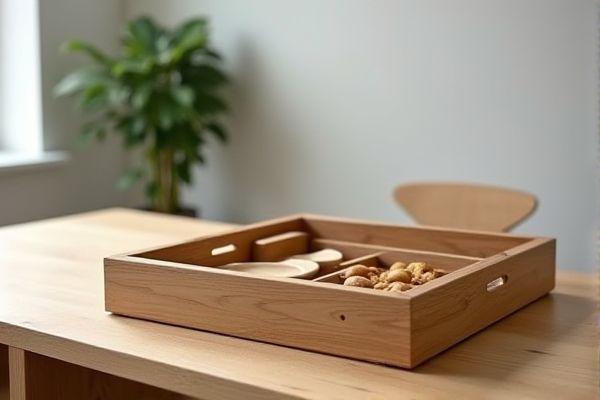
Stacking trays allow you to neatly pile items on top of each other, saving vertical space while maintaining easy access to each layer, whereas nesting trays are designed to fit inside one another, optimizing storage when not in use. Explore the rest of the article to discover which tray type best suits Your organizational needs.
Table of Comparison
| Feature | Stacking Tray | Nesting Tray |
|---|---|---|
| Design | Flat with raised edges for stacking | Conical or tapered shape for nesting inside each other |
| Space Efficiency | Moderate, trays stack vertically | High, trays nest to minimize storage space |
| Storage | Takes up more space when empty | Compact storage by nesting inside each other |
| Handling | Simple to stack and carry | Easy to separate when needed |
| Best Use | Ideal for transport and organized stacking | Suitable for limited storage space environments |
| Material | Usually rigid plastic or metal | Commonly plastic or lightweight material |
Introduction to Stacking and Nesting Trays
Stacking trays are designed with flat bottoms and raised edges, allowing them to be securely placed one on top of another, maximizing vertical storage space without slipping. Nesting trays feature tapered sides that enable them to be quickly nested inside one another when empty, reducing storage volume and saving space. Choosing the right tray depends on your storage needs: use stacking trays for efficient, stable stacking and nesting trays when minimizing empty storage space is a priority.
Definition: What Is a Stacking Tray?
A stacking tray is a flat container designed to be placed directly on top of another tray of the same size, creating stable vertical storage without occupying extra floor space. Unlike nesting trays, which fit inside each other to save space when not in use, stacking trays maintain their full capacity when combined. Your choice depends on whether you prioritize easy access and organization or efficient storage.
Definition: What Is a Nesting Tray?
A nesting tray is designed to fit securely inside another tray of the same type, minimizing storage space when not in use by stacking within each other. Unlike stacking trays, which stack on top without interlocking, nesting trays provide efficient space-saving through their tapered edges or shapes that allow them to nest neatly together. This design is ideal for environments where compact storage and easy access are essential, such as in kitchens or retail displays.
Key Differences Between Stacking and Nesting Trays
Stacking trays are designed with flat bases and uniform heights to allow one tray to be placed securely on top of another, maximizing vertical storage space. Nesting trays feature tapered sides that enable one tray to fit inside another, reducing storage volume and saving horizontal space when not in use. The key difference lies in stacking trays optimizing for height efficiency, while nesting trays prioritize compact storage and easier transportation.
Space Efficiency: Stacking vs Nesting
Stacking trays maximize vertical space by allowing items to be piled directly on top of each other, making them ideal for environments with limited floor area but ample height. Nesting trays slide or fit partially inside one another, significantly reducing storage footprint when not in use and enhancing portability. Choosing between stacking and nesting trays depends on whether your priority is efficient vertical storage or compact storage space during downtime.
Material and Durability Comparison
Stacking trays are typically made from rigid materials like hard plastic or metal, offering enhanced durability for heavy or frequent use. Nesting trays often feature lighter, more flexible materials such as polypropylene, allowing them to fit inside each other for space-saving storage but with slightly less robustness. Your choice depends on whether you prioritize long-term strength or compact storage efficiency.
Common Use Cases for Stacking Trays
Stacking trays are commonly used in environments where maximizing vertical storage space is critical, such as in warehouses and retail displays. They provide stability and allow easy access to individual layers, making them ideal for organizing small parts, office supplies, or inventory. In contrast to nesting trays, stacking trays maintain their height when placed on top of each other, supporting heavier loads and facilitating efficient space management.
Typical Applications for Nesting Trays
Nesting trays are commonly used in industries requiring compact storage and efficient space utilization, such as food service, warehousing, and manufacturing. Their design allows trays to fit within each other, minimizing volume during transport and storage. This feature makes them ideal for applications involving frequent movement and limited storage capacity.
Cost Analysis: Stacking Trays vs Nesting Trays
Stacking trays generally offer a lower upfront cost due to simpler manufacturing processes, while nesting trays may incur higher initial expenses because of their complex design. However, nesting trays can optimize storage space and reduce transportation costs, leading to long-term savings that stacking trays may not provide. Evaluating your workload and storage constraints helps determine which tray type delivers better overall cost efficiency for your operations.
Choosing the Right Tray for Your Needs
Stacking trays are designed to maximize vertical storage by securely placing one tray on top of another, ideal for organizing documents or office supplies while saving desk space. Nesting trays fit inside each other when not in use, making them perfect for easy storage and minimizing clutter in tight spaces. Choosing the right tray depends on your need for space efficiency during use or compact storage when idle.
 homyna.com
homyna.com